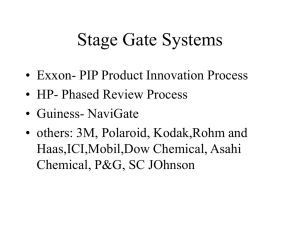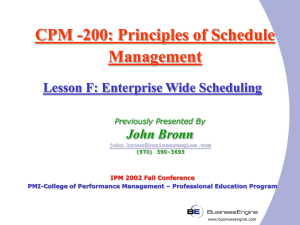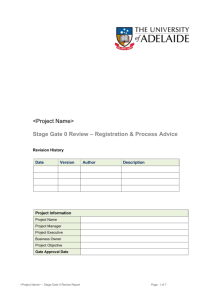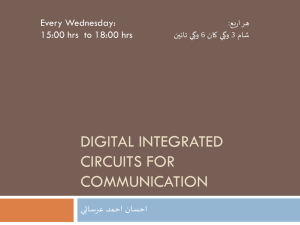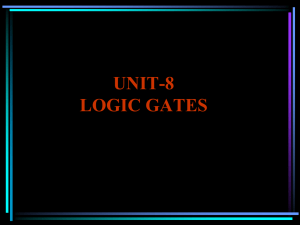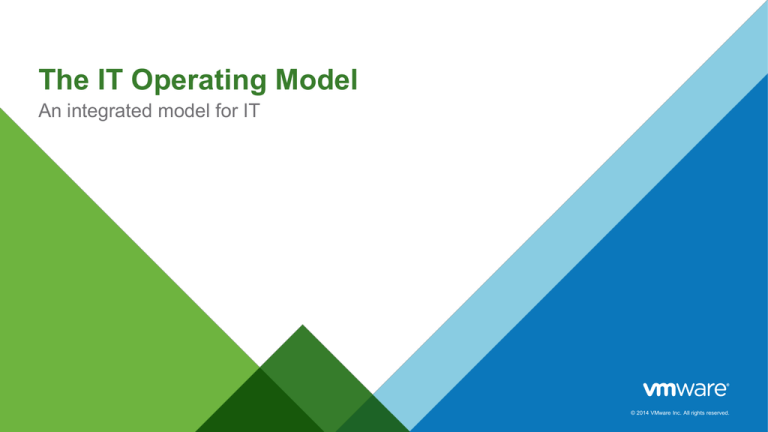
The IT Operating Model
An integrated model for IT
© 2014 VMware Inc. All rights reserved.
Introduction
• Richard Hawkins, Ph.D.
• VMware Transformation Strategist
• 35 years in IT – 20 consulting
• ITIL Expert
• Certified IT Architect
• Certified Project manager
• CISA
• CSAM
How come IT still doesn’t work right?
• ITSM – ITIL, ITPM, MOF, eTom
• Organizational Change – Kotter, ADKAR, Kubler, Bridge, EFQM
• COBIT – IT Governance
• Project Management – PMI, Prince2
• IT Asset Management - IAITAM
• Virtualization - SAAS, PAAS, IAAS, ITAAS, SDDC, Desktop AAS
• Enterprise/IT Architecture – Zachman, Togaf
• Quality Management – Six Sigma, PDCA, CMMI, ISO9000
• Security – ISO 2700x, ISO31000, NIST
• Risk Management – MOR
• Sourcing, Technology Roadmaps, Application Architectures, Data Management
3
IT Operating
Model
Introducing the IT Operating Model
Project Management Methodology
Project Initiation
Project Planning
Project Execution
Project Closure
Service Development Life Cycle
Transition
Planning
Manage IT Projects
Project Portfolio
Management
Project
Proposal
Service
Impacts
Business case
or SOW
Project
Charter
Approved
Quality Plan
Project Plan
Design Solution
(Physical
Architecture)
Analyze Solution
(Logical Architecture)
Risk Plan
Develop Solution
Code and Configure
Unit Testing
Design
Review
Build
Solution
User
Acceptance
Testing
Transition
Plan
Not Approved
Manage the lifecycle of all IT Projects
Proposal
Business Case
Service Model
Changes
Operational
Change
Management
Project
Proposal
Project
Definition
Schedule
Quality
Initiation
Complete
Save
proposal and
response
Communications
Plan
Financial
Plan
Communication
Plan
Logical
Architecture
Risk Matrix
Resource
Plan
Budget
Solution
Details
Physical
Architecture
As built
Planning
Complete
Resources
Supplier
Plan
Procurement
Plan
Availability
Planning
Capacity
Planning
Availability
Plan
Service Level
Management
Service
Metrics
Service
Level
Agreements
Capacity
Plan
Service
Catalog
Service
Continuity
Metrics
Events &
Responses
Security
Validation
& Testing
Change
Evaluation
Deployment
Plan
Knowledge
Items
Early Life
Support
Known
Errors
Test
Plan
Project
Closure
Evaluation
Plan
Lessons
Learned
Transition
Complete
Organizational
change
Org Change
Plan
Service Management Transition Artifacts
Security
Plan
Continuity
Plan
Service
Description
Release and
Deployment
Project
review
Configuration
Items
Event
Management
Build
Complete
Supplier
Management
RFC(s)
Knowledge
Management
SACM
Service Management Design Artifacts
Manage the Organization
Business Goals
And Objectives
Manage Organizational
Change
Provide IT Governance
Provide tools and techniques to manage
organizational change
IT Governance
Provide an overall IT strategy for achieving
business goals and objectives
Provide structure and criteria for making
quality IT business decisions
Manage the Business Relationship
Manage IT Assets
Strategic
Initiatives
Provide Centralized Communication
Manage Innovation
Manage IT
Communications
Innovation
Provide tools and techniques to enable
and ensure communications
IT Asset Management
Action
Not Viable
Alters Business
goals and objectives
Business
Requests
(Concept)
Manage Service Improvments
Continual Service
Improvement
Provide a framework for improving
services over time
Change
Proposal
Govern Intake
Service
Improvement
Plans
Manage Service Suggestions
Manage the Service Portfolio
Oversee Workload
Service Portfolio
Management
Provide Workload Priorities
Provide the structure and guidance to
manage the service portfolios
New
Service
Does not fit IT strategy
Or un-quantified
Business value
Define service,
customers, business
outcomes
Define service model
Define impact on
service portfolio
Define impact on
service model
Risk, Value to Cost,
Volatility, Mission
imperatives, Compliance
Trends, Intangible
benefits, Strategic or
business fit, Social
responsibility, Innovation
Run
Grow
Transform
Create value
proposition
Existing
Service
Manage IT Demand
IT Financial Management
Demand Management
Develop and manage the IT budget, Cost
Model and tracking methods
Proactively manage the demand for IT
resources
Manage People
Resource Management
Identify and manage risk in new and
ongoing services
Assign and track all IT resources
Project
Charter
Stage Gate 2
Not justified
(Business)
Monitor Events
Event Management
Placeholder
RFC
Analyze Solution
(Logical Architecture)
Develop Solution
Code and Configure
Unit Testing
Design Solution
(Physical Architecture)
Manage Tranision
Stage Gate 5
Solutions to not fulfill
business requirements
Service
Design
Package
Service
Transition
Package
Manage Applications
High-Level Service
Reference
Diagram
Architectures
High-Level Business
Service Relationship
Solution Diagram
Diagrams
7 Step Service
Improvement
Provide resources to manage IT
operations, backup, restore, etc
Provide service reports for all active
services
Analyze service and process reports and
recommend service improvements
Manage Improvements
Manage Recurring Interruptions
Incident Management
Problem Management
Provide a process for managing all
exceptions to production services
Provide a process for managing root cause
analysis and incident prevention
Manage Technology
Manage Applications
Provide Security
Operations
Can’t fulfill
Requirements
Not Practical
Service
Suggestions
Manage Reporting
Service and Process
Reporting
Provide response to known threats
Manage and track all IT projects and
programs
Service Architecture
Provide a framework to capture suggestions from
all IT processes and functions
Respond to Threats
Security
Alert
Build
Solution
Manage Service Interruptions
Known Error
Alert
Provide a framework for monitoring and
event management
Design Coordination
Manage IT Risk
Risk Management
Create Monitoring and
Service Metrics
Requirements
Create and maintain a framework for
service and process metrics
Manage Solution Design
Analyze investments,
value and priorities
Not feasible
Stage Gate 1
Does not fit in
the portfolio
Manage IT Finances
Business Case
Do not
Evaluate
Stage Gate 0
Invalid Request
IT Service Suggestions
Manage Monitoring Requirements
Stage Gate 3
Did not meet
Expectations
Provide sandbox environment for proof of
concept and non-standard solutions
IT Business Relationship
Management
Ensure that IT is proactive in addressing
the needs of the business
Manage the lifecycle of all IT Assets
Manage IT Operations
Provide IT Operations
Transition Planning and
Support
Security
Incident
Incident
Provide IT Strategy
IT Service Strategy
Management
Manage the transition from Development
to Production
Manage Data
Stage Gate 4
Resources not
available (IT)
Application Management
Manage Change
Change Management
Technology Management
Provide structure for managing change
development and approval
Manage Data
Manage development and maintenance of
enterprise technology
Small Requests
Manage IT Knowledge
Provide Self-Service
Provide a Single Point of Contact
Knowledge Management
Provide Self-Service to the
end users
Service Desk
Provide a process for managing the
creation and maintenance of KIs
Provide a mechanism for end users to report
incidents or request services
Provide a single point of contact for all IT related
contacts
Manage Technology
Manage Development and Maintenance
of enterprise applications
Service Portfolio Management
Request Fulfillment
Manage Releases
Release and Deployment
Management
Manage the release of changes into the
environment
Data Management
Manage development and maintenance of
enterprise data
Manage Service Requests
Request Fulfillment
Service Request
Ready to
Deploy
Ready for
Implementation
Provide a workflow method for managing
service requests
Manage Configurations
Manage Testing and Validation
Service Asset and
Configuration Management
Service Validation and
Testing
Change Evaluation
Provide a management repository for all
configuration items and service assets
Manage the integrated testing of services
Provide a process of evaluating the
success of changes in the environment
Manage Solution Value
Manage User Access
Access Management
Manage Service Levels
Provide a Service Catalog
Manage Availability
Manage Capacity
Service Level Management
Service Catalog
Management
Availability Management
Capacity Management
Ensure all IT services are delivered to
agreed targets
Provide a single source of information on
all operational services
Provide for Business Continuity
Service Strategy
Stage Gate 6
Business approval to
implement
Ensure IT services meet agreed availability
in a cost effective and timely manner
Manage IT Security
Manage Organizational
Change
Stage Gate 7
Business approval to
Deploy
Ensure IT services meet agreed capacity in
a cost effective and timely manner
Manage Vendors
IT Service Continuity
Management
Information Security
Management
Supplier Management
Support business continuity by managing
risks that could affect IT services
Ensure that the confidentiality, integrity, and
availability of the IT assets, data, information and
services meet agreed business needs
Ensure that all contracts and agreements with
suppliers support the needs of the business and all
suppliers meet their commitments
Service Design
PLAN
Provide a workflow method for managing
Access requests
Service Transition
BUILD
Continual Service
Improvement
Service Operations
RUN
4
5
IT Strategy
Initiatives
Maintenance
Growth
Business Requests
Enhancements
Service Requests
New Services
6
CONFIDENTIAL
7
8
CONFIDENTIAL
9
10
11
CONFIDENTIAL
12
Plan
Build
Run
Strategy
Design
Transition
Operations
Improvement
Architecture
Applications
Infrastructure
Operations
Administration
13
Closure
Transition
Execution
Planning
Initiation
14
15
Case Studies
• Add IT Governance
• Roadmap for ITSM
• Model for Organization Change
• Strategic Merger
• Education tool
• Process Alignment / Architecture
16





